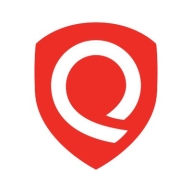


Qualys TotalCloud and Google Cloud Security Command Center compete in the cloud security management category. Google Cloud Security Command Center has the upper hand due to its comprehensive features and perceived value.
Features:Qualys TotalCloud is recognized for its extensive vulnerability management, compliance capabilities, and cost-effective solutions. Google Cloud Security Command Center is noted for advanced threat detection, seamless integration with Google services, and a robust range of security features.
Room for Improvement:Qualys TotalCloud users seek more intuitive dashboards, faster response times, and enhanced integration options. Google Cloud Security Command Center users desire better documentation, more customization options, and simplified interface navigation.
Ease of Deployment and Customer Service:Qualys TotalCloud is praised for its easy deployment and reliable customer support. Google Cloud Security Command Center is valued for seamless integration within Google environments though it has slower response times from customer support.
Pricing and ROI:Qualys TotalCloud is known for its competitive pricing and positive ROI appeal to budget-conscious users. Google Cloud Security Command Center has higher upfront costs but is justified by its extensive features and benefits valued by users.



SentinelOne Singularity Cloud Security protects cloud workloads, offering advanced threat detection and automated response. It integrates seamlessly with cloud environments and secures containerized applications and virtual machines against vulnerabilities.
SentinelOne Singularity Cloud Security is renowned for its efficiency in mitigating threats in real-time. The platform integrates effortlessly with existing cloud environments, ensuring robust cloud security management with minimal manual intervention. Securing containerized applications and virtual machines, it excels in threat intelligence and endpoint protection. However, improvements are needed in performance during high workload periods, and more integrations with third-party tools and better documentation would be beneficial. Users often find the installation process complex, support response times slow, and the dashboard's navigation unintuitive.
What are the key features of SentinelOne Singularity Cloud Security?In specific industries, SentinelOne Singularity Cloud Security is implemented to safeguard critical data and infrastructure. Organizations in finance, healthcare, and technology depend on its real-time threat detection and automated response to protect sensitive information. Its ability to secure containerized applications and virtual machines is particularly valuable in dynamic environments where rapid scaling is necessary.
Google Cloud Security Command Center streamlines security management by providing comprehensive visibility into asset security posture, empowering organizations to identify vulnerabilities and threats effectively.
Google Cloud Security Command Center offers a centralized platform for organizations to manage their security landscape, providing tools like threat detection and vulnerability scanning to protect cloud assets. Users benefit from its integration capabilities and detailed reporting, which enhance their ability to combat security challenges efficiently.
What are the key features of Google Cloud Security Command Center?Industries such as finance and healthcare benefit significantly from Google Cloud Security Command Center, as it helps them maintain compliance with strict regulations. Its ability to provide detailed security assessments and support integration with other cloud services makes it an essential tool for protecting sensitive data and ensuring uninterrupted service to customers.
TotalCloud is the Qualys approach to Cloud Native Application Protection Platform (CNAPP) for cloud infrastructure and SaaS environments. With TotalCloud, customers extend TruRisk insights (transparent cyber risk scoring methodology) from the Qualys Enterprise TruRisk Platform to their cloud environments allowing for a seamless unified view of cyber risk across on-prem, hybrid, and multi-cloud environments.
Features and capabilities of Qualys TotalCloud include, but are not limited to:
Discover: Complete visibility and insights into cyber-risk exposure across multi-cloud. Continuously discover and monitor all your workloads across a multi-cloud environment for a 360-degree view of your cloud footprint. Identify known and previously unknown internet-facing assets for 100% visibility and tracking of risks.
Assess: Comprehensive cloud-native assessments with FlexScanTM. Extensive scanning capabilities with Qualys FlexScan, including no-touch, agentless, API- and snapshot-based scanning, along with agent- and network-based scanning for in-depth assessment. Use these multiple scanning methods to scan a workload to get a unified and comprehensive view of vulnerabilities and misconfigurations.
Prioritize: Unified security view to prioritize cloud risk with TruRiskTM. Experience a unified risk-based view of cloud security with insights across workloads, services, and resources. Qualys TruRisk quantifies security risk by workload criticality and vulnerabilities; it correlates with ransomware, malware, and exploitation threat intelligence to prioritize, trace, and reduce risk.
Defend: Real-time protection against evolving and unknown threats with InstaProtectTM. Qualys enables continuous monitoring of all cloud assets to ensure they are protected against threats and attacks at runtime. Qualys keeps your cloud runtime safe by detecting known and unknown threats across the entire kill chain in near real-time across a multi-cloud environment.
Remediate: Fast remediation with QFlow – no code, drag-and-drop workflows. The integration of QFlow technology into Qualys TotalCloud saves security and DevOps teams valuable time and resources. Automation and no-code, drag-and-drop workflows help simplify the time-consuming operational tasks of assessing vulnerabilities on ephemeral cloud assets, alerting on high-priority threats, remediating misconfigurations, and quarantining high-risk assets.
We monitor all Cloud-Native Application Protection Platforms (CNAPP) reviews to prevent fraudulent reviews and keep review quality high. We do not post reviews by company employees or direct competitors. We validate each review for authenticity via cross-reference with LinkedIn, and personal follow-up with the reviewer when necessary.